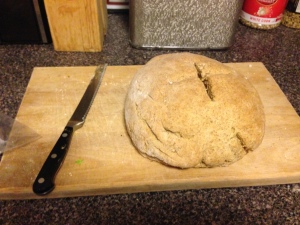Finals in full swing and a Nor’Easter raging outside, it can only mean one thing: bake-tastic baking!
I’m a softie for soft pretzels. When I made these the first time, my ever-wonderful partner in crime asked me where I got them. When I said “pinterest” he was confused because he was pretty sure that I had bought them from a professional rather than made them myself. In short: this recipe will not steer you wrong, folks! Enjoy it with some really good Dijon (I have personally taken to doing a 1 part Grey Poupon to 1 part whole-grain country mustard for optimal deliciousness).
Since these pretzels really only keep for two days or so, I do a half batch from the original recipe. It means that we can eat them before they lose their doughy goodness. Here’s my take on Sally’s delicious soft pretzels:
Ingredients
¾ cup warm water
1 packet (1/4 oz) Fleishmann’s active dry yeast; about 2 ¼ tsp
½ tsp kosher salt
½ Tbs light brown sugar
½ Tbs unsalted butter
approx. 2 cups all purpose flour
1 large egg
coarse sea salt to taste
Directions
Proof your yeast by dissolving it with a tiny pinch of sugar into the warm water. You want the water to be inside-of-wrist warm (technically 95 to 115 degrees Fahrenheit). Cover and let stand in a warm dark place for about eight minutes. If, when you come back, the mixture is bubbly, it means that your yeast is alive and good to go.
Melt your butter in the microwave (you want it just melted, not scorching) and add it to the yeast mixture along with the kosher salt and brown sugar. Stir this until the mixture is uniform. Slowly add your flour one half cup at a time until the mixture is thick and no longer sticks to the side of the bowl. If 2 cups doesn’t do it, add up to 1/8 of a cup more. If you can poke the dough with a finger and have it bounce back at you, then you know that it’s the correct consistency.
Turn out the dough onto a lightly floured surface and knead it for approximately three minutes. When you kneed, you’re strengthening the gluten (the long fibers which hold the dough together). You know that you’re done kneading if the dough is smooth and slightly tacky, and if it holds its shape when held into the air. When this is done, work the dough into a nice round ball.
Spray a mixing bowl with nonstick spray and place your dough ball in there. Cover and allow to rise in a warm dark place for ten minutes.
Preheat the oven to 425 degrees and line a prepare a baking sheet. I like to line mine in parchment paper with a thin coat of nonstick spray for good measure. If you have a Silpat, you can use that instead.
Cut your dough into three long sections and roll them into long thin ropes. Slice the ropes into bite-sized sections (I got about 37 from this recipe, but it depends on how big you want your bites!).
Now comes the key part: the baking soda bath. While this is the most pain in the butt portion of the recipe, it’s also vital to ensure proper pretzel consistency). Boil about 4 cups of water with ¼ cup of baking soda. When it has worked up to a good rolling boil, drop in 8 or so bites at a time and allow to boil for 20 seconds. With a slotted spoon, remove the bites and put them on your baking sheet. Repeat until you’ve boiled all of your bites.
Beat the egg and brush it over each bite. Sprinkle the whole shebang with coarse-grained sea salt, and bake for 15 minutes or until golden brown.
I’m told that these bites will freeze for up to three months and that they can be re-thawed in a 300F degree oven. To be completely honest, the batches I make never last long enough to be a problem.
Happy baking, and stay safe out there!


